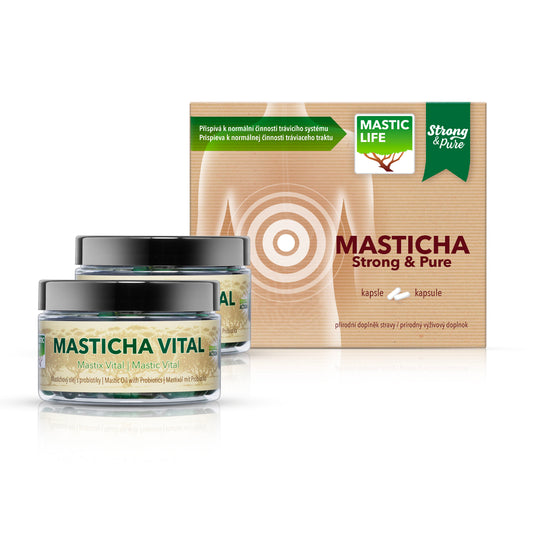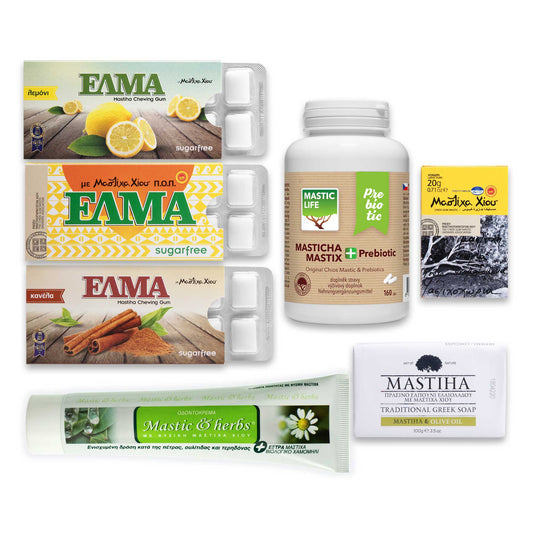Mastic: Cultivation and Production
The cultivation of mastic trees and the production of mastic is concentrated in a small area in the south of Chios - in the area of Mastichochoria (mastic village). The whole production is strictly organized.
The Association of Mastic Growers
All mastic production is organized within the Association of Chios Mastic Growers - Ένωση Μαστιχοπαραγωγών Χίου. This institution was established in 1938 as the sole administrator of a unique natural - mastic - in Greece and abroad. All owners of mastic trees are united in this kind of cooperative, currently it represents 4,500 members.
The association organizes and supervises the cultivation of trees, buys production, provides subsidies and especially ensures the processing and packaging of raw materials. In addition, it invests in research and development of new products. Centralization of raw mastic processing ensures consistent quality and uniform size sorting and distribution for direct consumption, production of powder for Masticlife dietary supplements, oils or more complex production - ELMA chewing gum, cosmetics, food ...
The year-round care of the trees themselves, the complex preparation for the collection and production of raw resin is a family affair for the owners or tenants of the mastic trees.

Care of Mastic Trees
Manuring
Growing mastic is a year-round job that requires constant attention, but the older the tree, the more care it requires. Usually in December, growers start manuring the mastic trees with natural fertilizer, including the fallen leaves of the mastic trees, and using so-called green manure to supply the plants with nitrogen.
Pruning
Mastic trees need to be pruned annually and rid of dry branches. In addition, a more extensive incision is made every approximately 5 years. Usually in mid-January and during February, the crowns are pruned in order to shape them so that the tree acquires an ideal shape for the passage of light and air circulation.
Mastic Plantations
Of course, when growing mastic, it is necessary to pay attention to the propagation of trees - the development and restoration of mastic groves. Propagation is done by cutting branches. This usually happens during February and March, but in practice you will encounter multiplication even in autumn. Medium to weaker branches are shortened to half a meter in length and in 3/4 of the length they are stripped of shoots and foliage. In rows and at intervals of 3 - 4 meters, the branches are placed longitudinally in a furrow 20 - 50 cm deep. It is necessary to provide irrigation in the spring. If propagation is carried out in autumn, the cuttings are sufficient to develop natural moisture and winter rains.
Mastic Collection
Preparatory Work
For future collection of mastic resin, it is necessary to prepare the soil under the trees. From mid-June and the beginning of July, the soil around the trees is cleaned and the terrain around the tree trunk is leveled so that the dripping mastic can be easily collected. The cleaning process is done in regular circles around the trunk.

The pre-prepared soil is sprinkled with white limestone powder, which is spread regularly to form a smooth surface. It is the culmination of preparation for the harvest, the groves of the mastic are perfectly clean and the impression of purity is further enhanced by the bright white of the soil under the trees.
The First Cut
Kentos, as we call small incisions in the bark of the mastic trees, are the most important stage in the production of mastic. The incisions are made in July and August, sometimes continuing until the end of September. A small tool with sharp points at the ends is used for the cut, which we call the kentitiri and also the so-called hammer - sfiraki. About half a centimeter wide notches in the bark are 10 - 15 cm long. They run slightly obliquely on the main branches. It starts at the lowest part of the trunk and continues to the crown. The incisions are made gradually over up to 6 weeks, usually in the morning.
Resin Effluent and Precipitation
The resin runs from the notches and at the same time it solidifies. It falls on the prepared ground under the trees or remains hanging on them. The drops solidify 15 - 20 days from the first incision, if it is a colder year, solidification can take only 10 days.
The First Collection
The first is to collect large pieces of resin, the so-called pítes. The resin is also collected or scraped from the branches and trunk. The remaining pieces are swept into a pile or collected by hand. The mastic is then stored in wooden crates in a cool place, where it is thoroughly cleaned to be ready for handover for further use.
Second Cut and Second Collection
While the first collection is based on the period after August 15, the feast of the Virgin Mary, the whole process of cutting is repeated so that the next collection begins after mid-September.
Mastic Processing
The collected mastic is stored in wooden hazelnuts in cool places in growers' houses. The next weeks and months are devoted to careful sorting and cleaning. The purchase price at which all the harvest is handed over to the association depends on the quality of this work.
The entire harvest volume ends up in the cold warehouses and production halls of the Association, where the mastic is cleaned again in several stages, sorted into three sizes and packaged for sale or further processing.
The factory also includes a line for crushing mastic. In the immediate vicinity is the ELMA factory, which produces chewing gum.
The Chios Mastic Growers Association compiles an overview of total production from processing to sorting by type and size (large, medium and small pieces) and other products such as ELMA chewing gum, mastic oil and mastic powder. Statistics are publicly available.
The Process of Making Mastic Lasts for Ages
It is worth mentioning that the production process and cultivation of mastic on Chios has not changed much since historical tradition:
- Yes, some cultivation practices have been slightly streamlined, but it's really just about finding the best ancestral experience.
- Yes, the cleaning and sorting of mastic is partly provided by machines, but it is still a purely mechanical process.
- Yes, the tools have soft padding, but in principle they remain the same as 500 years ago.
So the only thing that would surprise the visitor from the past could be an electric blower for faster cleaning of the soil under the trees.
Not only the mastic itself, but also the way it is obtained, persists for ages.
| Stage / Step | Description |
|---|---|
| Cultivation Area | Southern Chios, Mastichochoria (mastic villages); entire production strictly organized. |
| Association of Mastic Growers | Established 1938; manages cultivation, purchase, subsidies, processing, R&D; 4,500 members. |
| Manuring | December: natural fertilizer and green manure added; older trees require more care. |
| Pruning | Annual pruning to remove dry branches; extensive pruning every 5 years; done Jan–Feb. |
| Plantation Propagation | Branches cut Feb–Mar (or autumn); placed in furrows 20–50 cm deep; irrigation in spring. |
| Soil Preparation | Mid-Jun to Jul: clean soil, level terrain, sprinkle white limestone for collection of resin. |
| First Cut (Kentitiri) | July–Aug (sometimes Sep); small incisions 0.5 cm wide, 10–15 cm long on main branches; done gradually over 6 weeks in mornings. |
| Resin Effluent & Precipitation | Resin drips and solidifies on soil or branches; solidifies in 10–20 days depending on temperature. |
| First Collection | Collect large pieces (pítes), scrape resin from branches and trunk, sweep smaller pieces, store in wooden crates for cleaning. |
| Second Cut & Collection | After Aug 15; process repeated for second collection starting mid-Sep. |
| Processing & Sorting | Stored in cool places; sorted by size, cleaned, packaged for sale or further processing (powder, oil, chewing gum, cosmetics). |
| Crushing & Production | Mastic can be crushed for capsules or processed into ELMA chewing gum, cosmetics, and other products. |
| Quality Control | Association ensures consistent quality, uniform size, and monitors total production and other product lines. |
| Tradition & Tools | Most tools and methods unchanged for centuries; mechanical assistance like blowers may be used but core methods remain traditional. |
Mastic for your gastrointestinal tract
-
 8-week treatment 🗓️
8-week treatment 🗓️Mastic 8 weeks
Regular price £70.00 GBPRegular price£88.00 GBPSale price £70.00 GBPSale -
 60-day treatment 💪
60-day treatment 💪Mastic Gum Extra for 60 days
Regular price £125.00 GBPRegular price£157.00 GBPSale price £125.00 GBPSale -
 Gift set 🎁
Gift set 🎁Mastic „Life with Mastic"
Regular price £52.00 GBPRegular price£57.00 GBPSale price £52.00 GBPSale -
 Gift set 🌿
Gift set 🌿Mastic „Pure Mastic“
Regular price £27.00 GBPRegular price£30.00 GBPSale price £27.00 GBPSale





